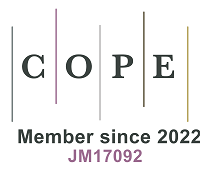REFERENCES
1. Nguyen, L.; Duong, L. T.; Mentreddy, R. S. The U.S. import demand for spices and herbs by differentiated sources. Journal. of. Applied. Research. on. Medicinal. and. Aromatic. Plants. 2019, 12, 13-20.
2. Galvin-king, P.; Haughey, S. A.; Elliott, C. T. Herb and spice fraud; the drivers, challenges and detection. Food. Control. 2018, 88, 85-97.
3. Kaefer, C. M.; Milner, J. A. The role of herbs and spices in cancer prevention. J. Nutr. Biochem. 2008, 19, 347-61.
4. Opara, E. I. Culinary herbs and spices: what can human studies tell us about their role in the prevention of chronic non-communicable diseases? J. Sci. Food. Agric. 2019, 99, 4511-7.
5. Opara, E. I.; Chohan, M. Culinary herbs and spices: their bioactive properties, the contribution of polyphenols and the challenges in deducing their true health benefits. Int. J. Mol. Sci. 2014, 15, 19183-202.
6. Embuscado, M. E. Spices and herbs: Natural sources of antioxidants - a mini review. J. Funct. Foods. 2015, 18, 811-9.
8. Kowalska, G. The Safety Assessment of toxic metals in commonly used herbs, spices, tea, and coffee in Poland. Int. J. Environ. Res. Public. Health. 2021, 18, 5779.
9. Akhtar, S.; Riaz, M.; Naeem, I.; et al. Risk assessment of aflatoxins and selected heavy metals through intake of branded and non-branded spices collected from the markets of Multan city of Pakistan. Food. Control. 2020, 112, 107132.
10. Reinholds, I.; Pugajeva, I.; Bavrins, K.; Kuckovska, G.; Bartkevics, V. Mycotoxins, pesticides and toxic metals in commercial spices and herbs. Food. Addit. Contam. Part. B. Surveill. 2017, 10, 5-14.
11. Shim, J.; Cho, Y.; Lee, K.; An, H.; Lee, C. Multivariate analysis of metals contents in spices commonly consumed in republic of Korea. Food. Addit. Contam. Part. B. Surveill. 2021, 14, 184-92.
12. Kim, S. U.; Kim, T. R.; Lee, E. S.; et al. Formaldehyde and heavy metal migration from rubber and metallic packaging/utensils in Korea. Food. Addit. Contam. Part. B. Surveill. 2015, 8, 7-11.
13. Kiyataka, P. H.; Dantas, S. T.; Pallone, J. A. Method for assessing lead, cadmium, mercury and arsenic in high-density polyethylene packaging and study of the migration into yoghurt and simulant. Food. Addit. Contam. Part. A. Chem. Anal. Control. Expo. Risk. Assess. 2014, 31, 156-63.
14. Alawadhi, N.; Abass, K.; Khaled, R.; Osaili, T. M.; Semerjian, L. Heavy metals in spices and herbs from worldwide markets: a systematic review and health risk assessment. Environ. Pollut. 2024, 362, 124999.
15. Shim, J.; Cho, T.; Leem, D.; Cho, Y.; Lee, C. Heavy metals in spices commonly consumed in Republic of Korea. Food. Addit. Contam. Part. B. Surveill. 2019, 12, 52-8.
16. Wong, C.; Roberts, S. M.; Saab, I. N. Review of regulatory reference values and background levels for heavy metals in the human diet. Regul. Toxicol. Pharmacol. 2022, 130, 105122.
17. Alam, M. N. E.; Hosen, M. M.; Ullah, A. K. M. A.; et al. Lead Exposure of four biologically important common branded and non-branded spices: relative analysis and health implication. Biol. Trace. Elem. Res. 2023, 201, 4972-84.
18. Cowell, W.; Ireland, T.; Vorhees, D.; Heiger-Bernays, W. Ground turmeric as a source of lead exposure in the United States. Public. Health. Rep. 2017, 132, 289-93.
19. Cicero, N.; Gervasi, T.; Durazzo, A.; et al. Mineral and microbiological analysis of spices and aromatic herbs. Foods 2022, 11, 548.
20. Das, A.; Das, A. Heavy metals in common food items in Kolkata, India. Euro-Mediterr. J. Environ. Integr. 2018, 3, 39.
21. Nordin, N.; Selamat, J. Heavy metals in spices and herbs from wholesale markets in Malaysia. Food. Addit. Contam. Part. B. Surveill. 2013, 6, 36-41.
22. Food Safety Authority (EFSA). Panel on contaminants in the food chain (CONTAM). Scientific opinion on lead in food. EFSA. J. 2010, 8, 1570.
23. Food Safety Authority (EFSA). Cadmium in food. Scientific opinion of the panel on contaminants in the food chain. EFSA. J. 2009, 980, 1-139.
24. Hungerford, N. L.; Tinggi, U.; Tan, B. L. L.; Farrell, M.; Fletcher, M. T. Mineral and trace element analysis of Australian/Queensland Apis mellifera honey. Int. J. Environ. Res. Public. Health. 2020, 17, 6304.
25. National Measurement Institute (NMI). Proficiency test final report AQA 21-12 metals in food. NMI 2022. https://www.industry.gov.au/sites/default/files/2022-10/AQA-21-12-Final-Report.pdf (accessed on 2025-08-18).
26. Baig, J. A.; Bhatti, S.; Kazi, T. G.; Afridi, H. I. Evaluation of arsenic, cadmium, nickel and lead in common spices in Pakistan. Biol. Trace. Elem. Res. 2019, 187, 586-95.
27. Food Safety Authority (EFSA). Dietary exposure to inorganic arsenic in the European population. EFSA. J. 2014, 12, 3597.
28. Ghasemidehkordi, B.; Malekirad, A. A.; Nazem, H.; et al. Concentration of lead and mercury in collected vegetables and herbs from Markazi province, Iran: a non-carcinogenic risk assessment. Food. Chem. Toxicol. 2018, 113, 204-10.
29. Pelcová, P.; Ridošková, A.; Hrachovinová, J.; Grmela, J. Evaluation of mercury bioavailability to vegetables in the vicinity of cinnabar mine. Environ. Pollut. 2021, 283, 117092.
30. Bua, D. G.; Annuario, G.; Albergamo, A.; Cicero, N.; Dugo, G. Heavy metals in aromatic spices by inductively coupled plasma-mass spectrometry. Food. Addit. Contam. Part. B. Surveill. 2016, 9, 210-6.
31. Food Standards Australia New Zealand (FSANZ). Contaminants and natural toxicants. 2024. https://www.foodstandards.gov.au/food-standards-code/legislation (accessed on 2025-08-18).
32. Dordevic, D.; Buchtova, H.; Jancikova, S.; et al. Aluminum contamination of food during culinary preparation: case study with aluminum foil and consumers’ preferences. Food. Sci. Nutr. 2019, 7, 3349-60.
33. Stahl, T.; Falk, S.; Taschan, H.; Boschek, B.; Brunn, H. Evaluation of human exposure to aluminum from food and food contact materials. Eur. Food. Res. Technol. 2018, 244, 2077-84.
34. Ba V, Thien BN, Phuong HT, Thi Hong Loan T, Anh TT. Bioconcentration and translocation of elements from soil to vegetables and associated health risk. J. Food. Compos. Anal. 2024, 132, 106296.
35. Ofoe, R.; Thomas, R. H.; Asiedu, S. K.; Wang-Pruski, G.; Fofana, B.; Abbey, L. Aluminum in plant: Benefits, toxicity and tolerance mechanisms. Front. Plant. Sci. 2022, 13, 1085998.
36. Callan, A.; Hinwood, A.; Devine, A. Metals in commonly eaten groceries in Western Australia: a market basket survey and dietary assessment. Food. Addit. Contam. Part. A. Chem. Anal. Control. Expo. Risk. Assess. 2014, 31, 1968-81.
37. Herting, G.; Wallinder, I. O.; Leygraf, C. Corrosion-induced release of chromium and iron from ferritic stainless steel grade AISI 430 in simulated food contact. J. Food. Eng. 2008, 87, 291-300.
38. Kamerud, K. L.; Hobbie, K. A.; Anderson, K. A. Stainless steel leaches nickel and chromium into foods during cooking. J. Agric. Food. Chem. 2013, 61, 9495-501.
39. Koo, Y. J.; Pack, E. C.; Lee, Y. J.; et al. Determination of toxic metal release from metallic kitchen utensils and their health risks. Food. Chem. Toxicol. 2020, 145, 111651.
40. Divrikli, U.; Horzum, N.; Soylak, M.; Elci, L. Trace heavy metal contents of some spices and herbal plants from western Anatolia, Turkey. Int. J. of. Food. Sci. Tech. 2006, 41, 712-6.
41. Caldeirão, L.; Sousa, J.; Nunes, L. C. G.; Godoy, H. T.; Fernandes, J. O.; Cunha, S. C. Herbs and herbal infusions: Determination of natural contaminants (mycotoxins and trace elements) and evaluation of their exposure. Food. Res. Int. 2021, 144, 110322.
42. Rahman, M.; Islam, M. A.; Khan, R. A. Characterization of chemical elements in common spices of Bangladesh for dietary intake and possible health risk assessment by INAA and AAS techniques. J. Radioanal. Nucl. Chem. 2018, 318, 1347-57.
43. Potortì, A. G.; Bua, G. D.; Lo, Turco. V.; et al. Major, minor and trace element concentrations in spices and aromatic herbs from Sicily (Italy) and Mahdia (Tunisia) by ICP-MS and multivariate analysis. Food. Chem. 2020, 313, 126094.
44. Khan, N.; Choi, J. Y.; Nho, E. Y.; et al. Determination of minor and trace elements in aromatic spices by micro-wave assisted digestion and inductively coupled plasma-mass spectrometry. Food. Chem. 2014, 158, 200-6.
45. Hay, E.; Lucariello, A.; Contieri, M.; et al. Therapeutic effects of turmeric in several diseases: an overview. Chem. Biol. Interact. 2019, 310, 108729.
46. Liu, S.; Liu, J.; He, L.; et al. A comprehensive review on the benefits and problems of curcumin with respect to human health. Molecules 2022, 27, 4400.
47. Bhathal, S. K.; Kaur, H.; Bains, K.; Mahal, A. K. Assessing intake and consumption level of spices among urban and rural households of Ludhiana district of Punjab, India. Nutr. J. 2020, 19, 121.
48. Carlsen, M. H.; Blomhoff, R.; Andersen, L. F. Intakes of culinary herbs and spices from a food frequency questionnaire evaluated against 28-days estimated records. Nutr. J. 2011, 10, 50.
49. Lampe, J. W. Spicing up a vegetarian diet: chemopreventive effects of phytochemicals. Am. J. Clin. Nutr. 2003, 78, 579S-83S.
50. Wilson, N. A.; Mantzioris, E.; Villani, A. Use of herbs and spices in cooking and food preparation in Australia. Proceed. Nutr. Society. 2024, 83, E97.
51. Suomi, J.; Valsta, L.; Tuominen, P. Dietary Heavy Metal Exposure among Finnish Adults in 2007 and in 2012. Int. J. Environ. Res. Public. Health. 2021, 18, 10581.
52. Food Safety Authority (EFSA). Safety of aluminium from dietary intake - Scientific opinion of the panel on food additives, flavourings, processing aids and food contact materials (AFC). EFSA. J. 2008, 6, 754.
53. Food Safety Authority (EFSA). CONTAM Panel (EFSA Panel on Contaminants in the Food Chain). Scientific opinion on the risks to public health related to the presence of chromium in food and drinking water. EFSA. J. 2014, 12, 3595.
54. Schrenk, D.; Bignami, M.; Bodin, L.; et al.; EFSA panel on contaminants in the food chain (CONTAM). Update of the risk assessment of nickel in food and drinking water. EFSA. J. 2020, 18, e06268.
55. World Health Organization (WHO). Concise international chemical assessment document 77- Strontium and strontium compounds. WHO 2010. https://iris.who.int/bitstream/handle/10665/44280/9789241530774_eng.pdf (accessed on 2025-08-18).
56. Allevato, E.; Stazi, S. R.; Marabottini, R.; D’Annibale, A. Mechanisms of arsenic assimilation by plants and countermeasures to attenuate its accumulation in crops other than rice. Ecotoxicol. Environ. Saf. 2019, 185, 109701.
57. Bergqvist, C.; Herbert, R.; Persson, I.; Greger, M. Plants influence on arsenic availability and speciation in the rhizosphere, roots and shoots of three different vegetables. Environ. Pollut. 2014, 184, 540-6.
58. Pavesi, T.; Moreira, J. C. Mechanisms and individuality in chromium toxicity in humans. J. Appl. Toxicol. 2020, 40, 1183-97.
59. Vincent, J. B. New evidence against chromium as an essential trace element. J. Nutr. 2017, 147, 2212-9.
60. Alvarez, C. C.; Bravo, Gómez. M. E.; Hernández, Zavala. A. Hexavalent chromium: Regulation and health effects. J. Trace. Elem. Med. Biol. 2021, 65, 126729.
61. Chung, S. W. C. Update on chromium speciation analysis in foods: a review of advances in analytical methods and dietary exposure assessment. Food. Addit. Contam. Part. A. Chem. Anal. Control. Expo. Risk. Assess. 2024, 41, 782-9.
62. Hernandez, F.; Bemrah, N.; Séby, F.; Noël, L.; Guérin, T. Cr(VI) and Cr(III) in milk, dairy and cereal products and dietary exposure assessment. Food. Addit. Contam. Part. B. Surveill. 2019, 12, 209-15.
63. Forsyth, J. E.; Nurunnahar, S.; Islam, S. S.; et al. Turmeric means “yellow” in Bengali: Lead chromate pigments added to turmeric threaten public health across Bangladesh. Environ. Res. 2019, 179, 108722.
64. Marx, D.; Rahimnejad, Yazdi. A.; Papini, M.; Towler, M. A review of the latest insights into the mechanism of action of strontium in bone. Bone. Rep. 2020, 12, 100273.







